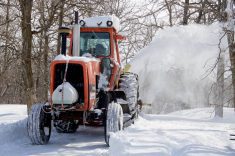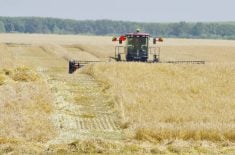Farmers in Manitoba got an involuntary break in their seeding and weed control operations in the second-last week of May, although that same rain brought relief to previously parched areas of the province.
“We went from warm days to heavy rains, to no rain, to freezing temperatures and kind of been all over the board,” said Lionel Kaskiw, a Manitoba Agriculture crop production specialist, during a weekly Crop Talk webinar May 21.
WHY IT MATTERS: Manitoba’s planting season had been hot and dry, but took an abrupt turn to the other weather extreme in mid-May.
Read Also

Still hard to predict precise fertilizer payback
Despite decades of advances, international research finds no clear answer for where and when adding nutrient will fail to boost growth.
Manitoba Agriculture weather data has shown incredible temperature fluctuations over the month, listeners heard.
“Our greatest temperature change in one day… was at Arborg, where we had a high of 30 degrees (Celsius) and a low of 0.2 degrees, which is a temperature variation of 30 degrees in one day,” said Alison Sass, an agriculture meteorology specialist with Manitoba Agriculture.
Within one seven-day period, data also recorded a climb from minus 6 C (recorded in Rorketon May 7) to 37.9 C in Petersfield, north of Selkirk, May 13.
Meteorologists raised their eyebrows at the early heat wave which, combined with strong winds, also exacerbated Manitoba’s already fraught wildfire situation. One quick-moving blaze sparked near Lac du Bonnet May 13 killed two people, and the latter part of that week saw an uptick in evacuations as several fires burned out of control.
In the first 21 days of May, multiple weather stations had recorded more than 10 days with gusts over 50 kilometres per hour.
“Minto had a max wind speed of 96 (km/h). Boissevain had a max wind speed of 93 on May 11,” Sass said.
Uneven rain complicates seeding
Rain came over the long weekend, but it didn’t hit everywhere, including disappointing totals in regions, such as the fire-pressed east, that had hoped for a good drenching.
The rainfall event did suddenly tip the southwest and central regions to nearly double their seasonal accumulation for this point in the season, but parts of the Interlake and east remain at less than 60 per cent of normal precipitation.
“We were seeing things varying just over the past week from rainfall and flood warnings in the southwest to wildfires in the east and the northwest,” Sass said May 21. “The highest monthly precipitation has actually been in Morden, with about 89 millimeters.”
Rain delayed field operations for about a week in southern Manitoba.
Despite that, seeding progress was still running ahead of the five-year average. The province’s weekly crop report May 21 put seeding at 57 per cent done, well above the long-term average of 45 per cent at that point in the season.

Soybeans bump canola
Canola seeding largely stalled during the wet and cold period.
“Producers were waiting for maybe some better weather, some heat, to make sure that they could get the crop in and out of the ground as quick as they can,” Kaskiw said.
Many farmers instead shifted focus to soybeans, he noted.
“At the time, it seemed early, but now it seems like it was maybe the best thing to do, when you look at the seeding progression for where we are right now,” Kaskiw said.
The provincial crop report suggested that 30 per cent of canola acres were in as of May 21, while 40 per cent of soybeans were also in the ground.
Patchy soil moisture
Shallow soil moisture conditions varied significantly across the province May 21.
Central, southwest and northwest Manitoba, along with western parts of the Interlake, were experiencing “wet to very wet conditions” at surface level, according to Sass. In the east and the rest of the Interlake, soil moisture was “optimal to dry,” with a few pockets of wetness.
Farmers now are in the latter part of the seeding season with a closing window, Kaskiw noted. Most crop types planted after the fourth week of May typically see yield potential reductions.
“We’re getting to that point where we need to start getting it in and taking advantage of the growing season,” he said.
First shoots
Winter cereals are showing promise, webinar attendees heard. Crops were able to take advantage of runoff moisture and so are tillering well and starting to fill in. Most fields suggest an average to above average crop, with minimal winter kill.
Emerging spring wheat has displayed yellowing. Specialists attribute to the cool, damp conditions and high winds, listeners heard. Crop conditions were expected to improve with warmer weather in the last week of May.
















